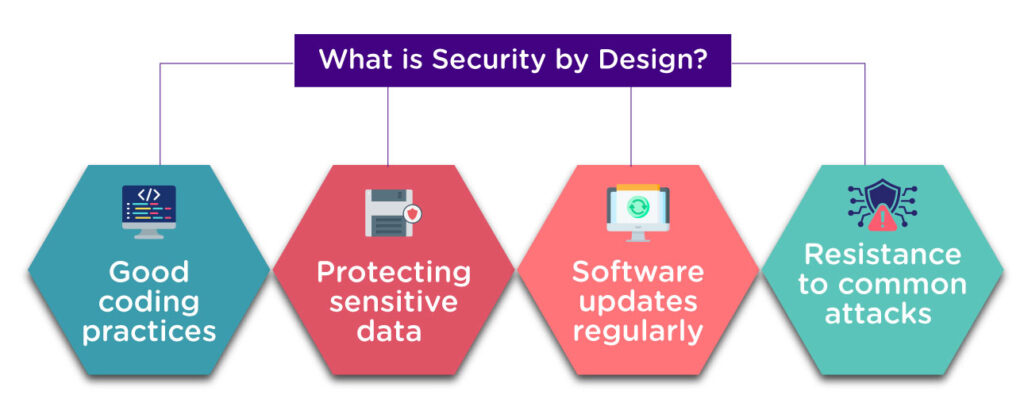The internet has become an essential part of our daily life through which we socialize, work, shop, and even manage devices in our homes using it. One major cause of this phenomenon is the emergence of Internet of Things, or IoT, referring to common appliances such as smart thermostats, security cameras, and health trackers connected to the internet.
But with this increase in IoT devices comes an important worry: cyber risks. There are many weaknesses in such devices that allow hackers to enter the system and, consequently, breach data, invasion of privacy, or even severe physical damage. This has led to significant discussion on creating ways to secure these devices from the very beginning and, in this case, brings us to "Security by Design."
What is Security by Design?
Security by design refers to an approach where security and a system or product are implemented from the onset. In the case of adding security after product design, in IoT products, security should start at the development stage with an adequate defense mechanism against cyber-attacks. Key practices include:

- Good coding practices
- Protecting sensitive data
- Software updates regularly
- Resistance to common attacks
For instance, as per the source, 78% of security professionals believe that including security during the design stage is very important for lowering the chances of data breaches and cyberattacks.
How Does Security by Design Work for IoT Devices?
Most of the IoT devices lack enough security input when designed. At times, they pay more attention to the ability of the device to work smoothly and easily to use than securing it from hackers. When it is built within the design, the security early solves the weaknesses of the given devices.
For example, a report from September 2024 says that the number of Internet of Things (IoT) devices is expected to almost double in the coming years. It is expected to increase from 15.9 billion in 2023 to more than 32.1 billion by 2030.
The following are a few examples of how security can be integrated with the devices from the onset:
- Secure Communication: Devices could prevent hackers from intercepting data when devices communicate through encrypted channels.
- Access Controls: Access to devices is controlled by using strong passwords and multi-factor authentication. It also involves deciding who should be allowed to access the devices.
- Regular Updates: Devices have the ability to update easily through patches that fix security problems that arise after they are sold.
- Data Security: Sensitive information, such as personal data or passwords, will be stored safely. It will be available to authorized people only.
If one designs the system considering these factors, then the risks of the compromise of a gadget are reduced highly.
Is Security by Design Useful for Cyber Risk Management?
This design approach is one of the most effective strategies for managing cyber risks. Its key benefit is that it addresses potential threats before they become real problems. Manufacturers can eliminate many common vulnerabilities that hackers usually exploit by planning for security early in the design process.
However, just like any approach, security by design is not perfect. One challenge is that many IoT manufacturers still prioritize speed and cost over security. Designing secure products requires extra effort, resources, and time, which can be expensive. In some cases, manufacturers may not have the necessary expertise or may not see the value in investing in secure design practices.
Are There Any Disadvantages of Security by Design?
The Security by design approach has many benefits, but it also comes with challenges. One major challenge is cost. Creating a product with strong security features can be more expensive than making a basic version. This might make some manufacturers hesitant to use it, especially if they want to keep their products affordable.
Another drawback is that secure design may be complex. Adding strong security features can make a product harder to use. For example, requiring users to create strong passwords or use multi-factor authentication may feel inconvenient, but these measures are the safest options.
Building a Secure Future: The Power of Security by Design for IoT Devices
The Security designs manage cyber risks very well for IoT. The security element is taken into consideration during early design stages such that devices may be created and become more resistant to hackers' exploitation. It is true that there are disadvantages, including higher costs and greater complexity, which outweigh the advantages.
As connected devices are increasing in number, they must be secured at the very beginning. Security by design thus forms a positive approach to the ever-increasing cyber threats, saving the user from possible harm done to them and their data.
For more such informative blogs, visit SecureITWorld!
FAQs
Q1. What is the cybersecurity by design approach?
Answer. Cybersecurity by design refers to designing or planning a product or system with built-in security features at inception instead of just being added later in the development. In other words, it incorporates security into every part of the process.
Q2. What are IoT devices, and how can we protect them?
Answer. IoT devices can be prone to hacking, data breaches, and privacy issues. We should protect them by using encrypted communication, strong passwords, regular software updates, and making sure that sensitive data is stored securely.
Q3. What is the most important success factor in designing an effective IT security awareness program?
Answer. The most crucial factor is to make clear and compelling communication. The program should be communicable, consistent with employees' working roles, and constantly updated to reflect contemporary security threats.
Recommended For You:





